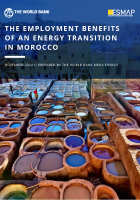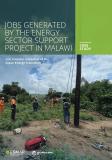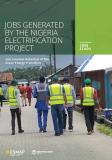Publications
This report estimates the job creation potential of Morocco’s ambitious renewable energy and energy efficiency targets. To do this, it uses the Clean Energy Employment Assessment Tool (CEEAT), an excel-based input-output model that can stimulate the economy wide net direct, indirect, and induced employment impacts of clean energy technology pathways. CEEAT is currently calibrated for six such pathways: utility-scale solar, concentrated solar power, industrial solar, rooftop residential solar, utility-scale wind, and energy efficiency of buildings. Achieving Morocco’s targets for these technologies would yield an estimated 762,000 net job-years over the next 30 years, equivalent to an average of 25,000 additional new job opportunities per year. This is 8.5 percent of the country’s overall 300,000 annual jobs shortfall. The results could be even more impressive, if other clean energy technologies were to be considered, offering a more complete picture of the energy transition in Morocco. The early results of analysis showcase important benefits of striving for a sustainable energy pathway, even for an emerging economy. Not only would jobs be gained, which could inform future strategies for workforce development, but some jobs would be displaced, or possibly shifted. A just transition framework is needed to mitigate any negative impacts and maximizing the employment co-benefits of a green economy.
World Bank.
The Employment Benefits of an Energy Transition in Morocco (English). Washington, D.C. : World Bank Group. http://documents.worldbank.org/curated/en/099045112072229005/P17054605f2e8209208fa80241ca43a9fa7




